On the road in Agadez: desperation and death along a Saharan smuggling route
As political leaders prepare to meet in Malta to discuss measures to stem the flow of migrants and refugees from Africa to Europe, Patrick Kingsley meets the smugglers and the smuggled on a route through the desert from Niger
Migration
On the road in Agadez: desperation and death along a Saharan smuggling route
As political leaders prepare to meet in Malta to discuss measures to stem the flow of migrants and refugees from Africa to Europe, Patrick Kingsley meets the smugglers and the smuggled on a route through the desert from Niger
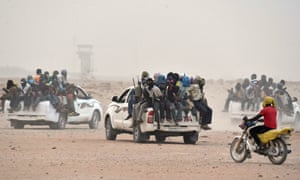
People sit on the open cargo of pick-up trucks, holding wooden sticks tied to the vehicle, as they leave the outskirts of Agadez for Libya. Photograph: Issouf Sanogo/AFP/Getty Images

Patrick Kingsley in Agadez
Monday 9 November 2015 14.58 GMTLast modified on Tuesday 10 November 201509.44 GMT
Share on Pinterest
Share on LinkedIn
Share on Google+
Shares
1,507
Comments201
Save for later
You can’t see the road from Agadez in Niger to Libya. You simply drive to the edge of the local airstrip, turn left, fork right, head past the one building on the horizon – a lonely police checkpoint – and that’s it. Only a select few local drivers know which dunes lead across the Sahara and which ones lead to oblivion. And in three days of driving, there are plenty of wrong turnings to make.
Yet before they risk death in the Mediterranean Sea, before they cross the battlegrounds of the Libyan civil war, and well before a tiny few of them reach the new security fences at Calais, most migrants from west Africa must pass along this road. Many of them die on it.
A sandstorm in Agadez, August 2015. In the desert, sandstorms can disorientate smugglers, alter the terrain, and throw them off course – causing some to die of thirst.
Cisse Mahamadou explains why. A people-smuggler from Agadez, Mahamadou makes the journey once a week, along with 30 passengers in his pick-up truck. Each time the route looks different, thanks to regular sandstorms that change the shape of the desert. Mahamadou knows the Sahara “like it’s my bedroom”, but others don’t, so they get lost. And once lost, they run out of fuel – and then water. “And if there is no water,” says Mahamadou, 25, “you won’t survive for more than three days”.
Then there are the bandits: rival smugglers, jihadis, or simply opportunists looking to steal cars, leaving their previous drivers in the desert. “If you’re lucky you will be rescued,” says Mahamadou, a geologist by training. “If you’re not, they’ll kill you and your passengers as well.”

FacebookTwitterPinterest A truck of passengers on the road to Libya. Photograph: Aldo Pavan/Lonely Planet Images/Getty Images
No one can know how many have died in this way. For every corpse discovered in the Sahara – more than 40 have been counted since January – there may be another five or even 50 that will never be found. “In my opinion,” reckons Joel Gomez, a failed footballer from Cameroon and one of Mahamadou’s passengers, “the Sahara is more dangerous than the Mediterranean”. Yet record numbers are still risking it.
European and African leaders will meet in Malta on Wednesday to discuss possible measures to curb this flow. They would be better off going to Agadez to see the desperation of the people they want to stop – and the difficulties of attempting to do so.
It is late on a summer’s night, and Mahamadou and Gomez mill around one of Agadez’s main bus stations. Here on the southern cusp of the Sahara desert, hundreds of migrants arrive legally each night. By the end of the year, local officials say, their numbers will have topped 100,000. This is the northernmost edge of the Ecowas zone, a Schengen-like visa-free swath of west Africa. Within the zone, anyone with means can take a bus from the coast of Nigeria to the edge of the Sahara desert in Niger. In Agadez the bus drivers stop and the people-smuggling begins.
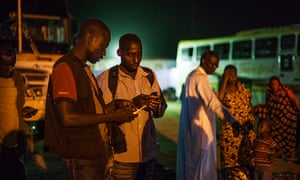
FacebookTwitterPinterest Two migrants from Burkina Faso exchange telephone numbers upon arriving to Agadez, Niger. This is the final stop of commercial buses. The journey from here will be facilitated by a network of smugglers who drive small pick-up trucks. Photograph: The Washington Post/Getty Images
The bus travellers totter out, often nauseous after a 20-hour ride along bumpy roads. Most have specific people to call – smugglers recommended by friends who’ve successfully made the trip in the past. Others approach the smugglers on arrival. And then they’re all driven to the compounds.
Agadez is a squat town, a warren of low clay buildings circling a single tall structure, a 27m-high minaret that looms above its surroundings. The houses it overlooks are mostly single-storey courtyards, each enclosed by a windowless wall. These are the compounds, and perhaps 50 of them are used by smugglers – though no one knows the exact total. They’re the perfect places to hide 100 migrants until they head north to Libya.
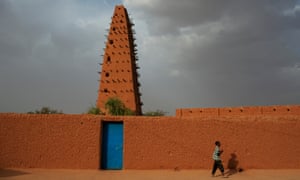
FacebookTwitterPinterest The minaret of the grand mosque at Agadez, which was first built in the 16th century. Photograph: Joe Penney/Reuters
Once inside, the haggling starts. The going rate between Agadez and Libya is thought to be about 150,000 West African francs (CFA), or £166. But one traveller said he paid as much as €500 (£363), while Mahamadou claims he charges each of his 30 passengers as little as 50,000 CFA (£55).
Even this amount is more than many in west Africa earn in one month, and perhaps counter-intuitively, that is why people are paying it. According to the International Organisation for Migration (IOM), most of those who pass through Agadez are not fleeing wars or political repression (unlike the vast majority of those reaching Europe from other routes, who are mostly refugees). Instead, they are largely trying to find a way out of grinding poverty. The international community does not deem this a legitimate reason to seek a new life in Europe. But the people passing through Agadez do, otherwise they wouldn’t risk death in trying it.
Everyone has a story like that of Paul Ohioyah, a Nigerian who passed through Agadez this summer. Ohioyah is a plumber and part-time pastor, who borrowed $3,000 (£1,950) to head to Europe. Why? Because back home, he says, he couldn’t put food on the table; he’d get only two plumbing jobs a month. “So before you’ve got another customer, you’ve had to spend what you earned the last time,” says Ohioyah, 31. “It’s better that I die here than I go back to Nigeria.”
Ohioyah’s friend, Ojeomokhai Felix, has even stronger rhetoric. “Countries at war are better than Nigeria,” argues Felix, a 33-year-old engineer. “People are still dying there of hunger or sickness because they have no money for food or hospitals. Somebody who sold his house for $3,000 to go to Europe can’t go back to his country. It’s better he kills himself than goes back.”
Driving people like Felix to Libya is now supposed to be illegal. In May, following pressure from the EU, which runs two missions in the country, the Nigerien government banned people-smuggling. Agadez’s police chief, who asks to be referred to by his role rather than his name, is keen to talk about his enforcement of the ban. Since May, he says, his men have arrested 14 smugglers; another was successfully encouraged to retire from the trade.
But what about corruption – do smugglers still bribe policemen to let them through their checkpoints? “Two years ago, what you said could be a reality,” claims the chief. “But after that event, all the policemen who did that were sent elsewhere. And because of that, the newcomers are very afraid. So now no vehicle goes by the checkpoint of the police.”
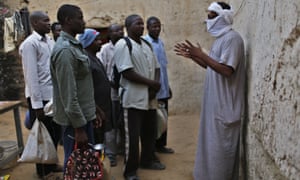
FacebookTwitterPinterest A smuggler (with covered face) talks to a group of men. Photograph: Ahmed Jadallah / Reuters/Reuters
Step outside his office, however, and it is clear that many smugglers still operate under the police’s protection. Mahamadou (not his real name) is a case in point. Since the law’s implementation, he’s been careful. When a journalist calls to schedule an interview, he fears it’s a sting. Tellingly, the man Mahamadou sends to screen the journalist is a plain-clothes policeman in his pay. At each of the three checkpoints before Libya, Mahamadou pays the police 10,000 CFA (£11) per passenger to let them pass. “The law has changed nothing,” he smiles. “If you pay certain bribes to the police you can continue to operate the compounds.”
The rhythm of the town still operates around the smugglers’ schedule. For most of the week, Agadez is subdued. But as Monday approaches – the day that most smugglers leave together, for protection – the town suddenly plunges into fast-forward. The smugglers’ cars of choice – white Toyota pick-up trucks with blacked-out windows and ripped-off license plates – scurry around the streets in greater numbers. They’re taken to the mechanics for any last-minute repairs. Then they’re loaded with spare fuel and water; Mahamadou buys 470 litres of the former, and 250 of the latter. No one in the town seems fazed.
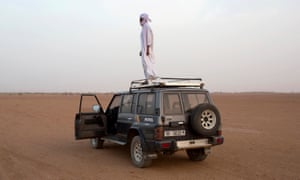
FacebookTwitterPinterest A people smuggler looks out for cars driven by his colleagues coming from Libya at a checkpoint outside Agadez. Photograph: Joe Penney/Reuters
At last, on Monday afternoon, each smuggler gathers 30 passengers outside their compound, and crams them into the back of their Toyota. Sometimes the drivers come from Libya, and the profits are shared between him and the Nigerian compound owner. Other times it’s Nigerians like Mahamadou who do the driving themselves.
Either way, both methods see the smugglers try to squeeze every last drop of profit from their clients. The passengers are packed so tightly that those on the outside face outwards, with their legs hanging from the parapet. Once in position, they grip on to sticks attached to the car frame, to stop them falling out when the car picks up pace.
And then they’re off, skidding past the airstrip, and out towards the lonely police checkpoint. Here, the drivers’ colleagues linger by the policemen’s hut to make sure the officers get their cut. One radios his colleagues back at the compound. “Get a move on,” he says. “The way is clear.” Minutes later, the smugglers’ trucks hurtle past, and the policemen look the other way – more interested in the presence of a journalist’s car than a smuggler’s.
The police aren’t the only ones turning a blind eye. The reason the smugglers leave en masse on Monday is so that they can tag along with the weekly military convoy into the desert. No one seems to mind. “The army led us out of the town,” remembers Ohioyah. “And the army didn’t stop anyone.”
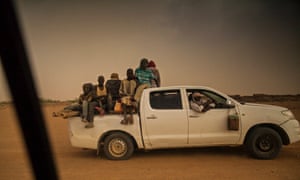
FacebookTwitterPinterest A pick-up truck filled with migrants in Agadez. The journey should take three days – but often takes much longer. Photograph: The Washington Post/Getty Images
Almost everyone admits it would be hard, if not impossible, to meaningfully curb smuggling in Agadez. In one of the world’s poorest countries, and in a town that has no other substantial industries, smuggling is a vital financial lifeline for many local people. In just one trip, a smuggler might make as much as 4.5 million CFA (£4,985). In a year, he could take in as much as £250,000. And if 100,000 people do transit through the town in 2015, then that could feasibly rake in a total of £16.6 million – and that’s before bribes worth £1.1 million for the police.
This money is particularly significant in a town that has many boarded-up travel agencies. Until eight years ago, Agadez was a tourist town, and its little airstrip technically an international airport. But then came a wave of local Berber rebellions, and the rise of a regional al-Qaida franchise. And so the tourist trade suddenly stopped – and even when things quietened down again, it never came back.
An adviser to the Sultan of Aïr, the town’s ceremonial leader, sighs. “This is part of what’s happening,” says Mohamed Tuwara, sitting in the shadow of the town’s famous minaret. “Because of the rebellions, the tourists won’t come to Agadez any more, and the craftsmen don’t sell their products. Many people have to change their work, so some of the craftsmen become gardeners, and there are some who become smugglers.”

FacebookTwitterPinterest The Sultan of Aïr’s special advisor. Photograph: Patrick Kingsley/Guardian
In his mid-teens, Mahamadou used to drive tourists around the desert. Now he takes migrants through it. It’s this kind of story that makes some local politicians wary of enforcing a smuggling ban without simultaneous economic investment in the area.
Mohamed Anacko, the head of the regional parliament, sips tea at a friend’s house. While smuggling remains such an economic crutch for the area, Anacko says, smugglers will still risk it even if the police start doing their jobs properly. “If they can’t go through the police, they’ll go around the places with the police,” Anacko says gently. “And that’s a problem because they’re even more likely to get lost.” And this, in turn, will cause more deaths.
Those who have survived the journey can nevertheless scarcely imagine how it could get more dangerous. Pape Demba Kebe, a 33-year-old welder from Senegal, crossed the Sahara in August, and during a toilet break his group discovered the bodies of two men. Their driver acted like it was a normal discovery. “One was on his back,” remembers Kebe, “and the other had died while he was praying. So we buried them.”

FacebookTwitterPinterest Pape Demba Kebe, a Senegalese welder. His truck encountered the bodies of two men in the desert – a common occurrence. Photograph: Patrick Kingsley/Guardian
Perhaps the worst part of the journey happens on arrival in Libya. Most passengers are dropped off in Qatroun, the first major town over the border, or in Sabha, further to the north. A few of them won’t have paid upfront, and so the macabre understanding is that they will be locked in a compound in Libya until either their families or sympathetic local migrant workers pay a ransom.
Those who paid in Niger are supposed to be released, to allow them to find new smugglers to take them north through the desert to Tripoli, or to earn money that will allow them to pay for this onwards journey. The problem is, many people aren’t let go – and the smuggling business turns into a trafficking one. The victims include Paul Ohioyah, the plumber and part-time pastor. On arrival in Qatroun, a Libyan militia seized Ohioyah’s group and drove them to Sabha, where they were shut in another compound. “Some people came and said: we bought you with money,” remembers Ohioyah. “So they said we had to pay them back. But I’d already paid €500 – I didn’t have that money.”
So Ohioyah stayed locked up for a month. He was only released because a fellow inmate died of illness and another died after a beating by their jailers, prompting the superstitious compound owner to want rid of an unlucky cohort of inmates. Ohioyah wasn’t tortured but many in his situation have been, according to the Red Cross in Agadez, which treats some of those kidnapped in southern Libya when and if they manage to return to Niger. “If someone’s parents pay within one day, no problem, he leaves,” says Ismail Mohama, the Red Cross’s migration coordinator in Agadez. “But if not, [the traffickers] will torture him. They usually have wounds from beatings on their backs, and sometimes on their heels. At the moment they are calling their parents, they beaten on their feet.”

FacebookTwitterPinterest Refugees wait to disembark from the Italian Navy vessel Chimera in the harbor of Salerno, Italy. Photograph: Francesco Pecoraro/AP
Stories like these help explain why many African migrants in the north of Libya feel they have no choice but to risk the sea voyage to Europe, even if they don’t have the right to political asylum. Some might have seen Libya as their final destination, somewhere they could make their fortune, and then return home with pride. But with a civil war raging and no one to protect them, most migrants are at risk of kidnap, extortion and forced labour. So they need to leave. But the route back through the desert to Agadez is just as expensive as the Mediterranean voyage, and the risks are similar. Moussa Fofana, a 33-year-old Malian, tried it in August. On the drive to Agadez, his car was ambushed by Libyan youths, and all the money he had saved in Libya was taken. “They were boys with Kalashnikovs who robbed us,” he laughs. “They even took my clothes.”
Back in the bus station, Mahamadou cites this kind of desperation to show why Europe’s current attitude to migration is short-sighted. Individual countries are building fences here, fences there, he says. But such local responses don’t really acknowledge the broader, global causes of migration – factors which become more apparent when you visit Agadez. “A fence, even an electrified fence, won’t stop migration,” argues Mahamadou. “These people are suffering, and they will travel anywhere where they can find a better life.”
Mahamadou’s passengers are mostly so-called economic migrants whom European politicians heading for Malta hope to deter from Europe with the threat of swift deportation. But if the migrants’ rhetoric is a guide, it will take more than that threat to stop them from attempting the journey. Joel Gomez, one of Mahamadou’s passengers in the bus station, says Europe’s duty is to repay centuries of colonialism by welcoming the unemployed of Africa.
“The white man arrived in Africa by sea without a visa,” says the Cameroonian. “And we have learned to travel from the white man.”
Additional reporting by Chehou Aziz
http://www.theguardian.com/world/2015/nov/09/on-the-road-in-agadez-desperation-and-death-along-a-saharan-smuggling-route